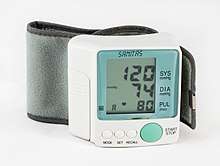Non-invasive procedure
A medical procedure is defined as non-invasive when no break in the skin is created and there is no contact with the mucosa, or skin break, or internal body cavity beyond a natural or artificial body orifice. For example, deep palpation and percussion are non-invasive but a rectal examination is invasive. Likewise, examination of the ear-drum or inside the nose or a wound dressing change all fall outside the definition of non-invasive procedure. There are many non-invasive procedures, ranging from simple observation, to specialised forms of surgery, such as radiosurgery. Extracorporeal shock wave lithotripsy is a non-invasive treatment of stones in the kidney,[1]gallbladder or liver, using an acoustic pulse. For centuries, physicians have employed many simple non-invasive methods based on physical parameters in order to assess body function in health and disease (physical examination and inspection), such as pulse-taking, the auscultation of heart sounds and lung sounds (using the stethoscope), temperature examination (using thermometers), respiratory examination, peripheral vascular examination, oral examination, abdominal examination, external percussion and palpation, blood pressure measurement (using the sphygmomanometer), change in body volumes (using plethysmograph), audiometry, eye examination, and many others.

Diagnostic images
- Bioluminescence imaging
- Dermatoscopy
- Diffuse optical tomography
- Gamma camera
- Computed Tomography
- Infrared imaging of the body
- Magnetic resonance elastography
- Magnetic resonance imaging,
- Magnetic resonance spectroscopy
- Optical coherence tomography
- Posturography
- Radiography, fluoroscopy
- Ultrasonography and echocardiography
Diagnostic signals
- Electrocardiography (ECG)
- Electroencephalography (EEG)
- Electromyography (EMG)
- Photoplethysmograph(PPG)
- Electrical impedance tomography (EIT)
- Electroneuronography (ENoG)
- Electroretinography (ERG)
- Electronystagmography (ENG)
- Magnetoencephalography (MEG)
- Evoked potentials
- Impedance phlebography
- Nuclear magnetic resonance
Therapy
- Epidermal radioisotope therapy
- Radiation therapy
- Brachytherapy
- Lithotripsy
- Defibrillation
- Biofeedback
- Oxygen therapy
- Non-invasive ventilation
- VPAP
- BIPAP
- Neurally adjusted ventilatory assist
- Biphasic cuirass ventilation
- Therapeutic ultrasound
See also
Minimally invasive procedures
References
- Srisubat, A; Potisat1, S; Lojanapiwat, B; Setthawong, V; Laopaiboon, M (24 November 2014). "Extracorporeal shock wave lithotripsy (ESWL) versus percutaneous nephrolithotomy (PCNL) or retrograde intrarenal surgery (RIRS) for kidney stones". The Cochrane Library. 11 (11): CD007044. doi:10.1002/14651858.CD007044.pub3. PMID 25418417.